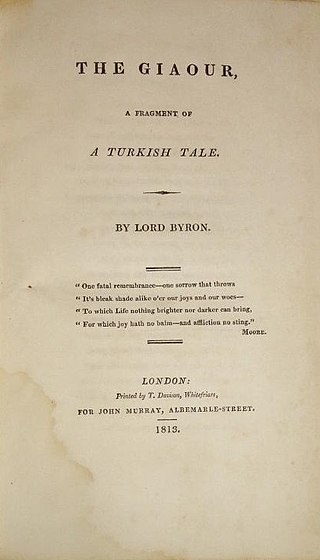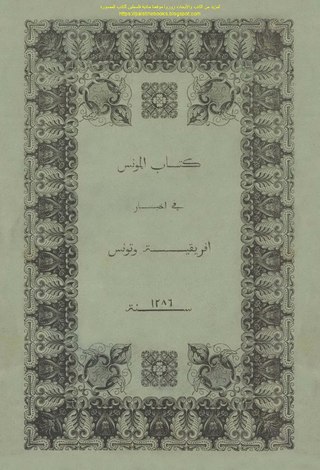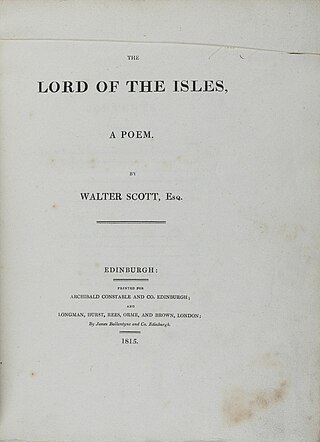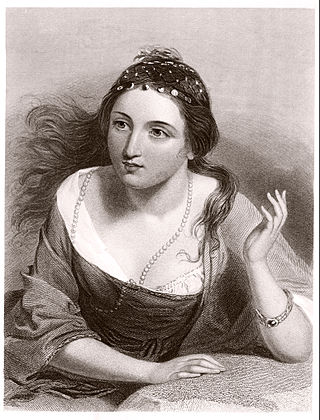
Corsairs were privateers, authorised to conduct raids on shipping of a foreign state at war with France, on behalf of the French crown. Seized vessels and cargo were sold at auction, with the corsair captain entitled to a portion of the proceeds. Although not French Navy personnel, corsairs were considered legitimate combatants in France, provided the commanding officer of the vessel was in possession of a valid letter of marque, and the officers and crew conducted themselves according to contemporary admiralty law. By acting on behalf of the French Crown, if captured by the enemy, they could in principle claim treatment as prisoners of war, instead of being considered pirates.

The Byronic hero is a variant of the Romantic hero as a type of character, named after the English Romantic poet Lord Byron. Both Byron's own persona as well as characters from his writings are considered to provide defining features to the character type.

The Barbary pirates, Barbary corsairs, or Ottoman corsairs were mainly Muslim pirates and privateers who operated from the Barbary states. This area was known in Europe as the Barbary Coast, in reference to the Berbers. Slaves in Barbary could be of many ethnicities, and of many different religions, such as Christian, Jewish, or Muslim. Their predation extended throughout the Mediterranean, south along West Africa's Atlantic seaboard and into the North Atlantic as far north as Iceland, but they primarily operated in the western Mediterranean. In addition to seizing merchant ships, they engaged in razzias, raids on European coastal towns and villages, mainly in Italy, France, Spain, and Portugal, but also in the British Isles, the Netherlands, and Iceland.

Childe Harold's Pilgrimage is a long narrative poem in four parts written by Lord Byron. The poem was published between 1812 and 1818. Dedicated to "Ianthe", it describes the travels and reflections of a young man disillusioned with a life of pleasure and revelry and looking for distraction in foreign lands. In a wider sense, it is an expression of the melancholy and disillusionment felt by a generation weary of the wars of the post-Revolutionary and Napoleonic eras. The title comes from the term childe, a medieval title for a young man who was a candidate for knighthood.

The Giaour is a poem by Lord Byron first published in 1813 by John Murray and printed by Thomas Davison. It was the first in the series of Byron's Oriental romances. The Giaour proved to be a great success when published, consolidating Byron's reputation critically and commercially.

Le Corsaire is a ballet typically presented in three acts, with a libretto originally created by Jules-Henri Vernoy de Saint-Georges loosely based on the poem The Corsair by Lord Byron. Originally choreographed by Joseph Mazilier to the music of Adolphe Adam and other composers, it was first presented by the ballet of the Théâtre Impérial de l’Opéra in Paris on 23 January 1856. All modern productions of Le Corsaire are derived from the revivals staged by the Ballet Master Marius Petipa for the Imperial Ballet of St. Petersburg throughout the mid to late 19th century.

Il corsaro is an opera in three acts by Giuseppe Verdi, from a libretto by Francesco Maria Piave, based on Lord Byron's 1814 poem The Corsair. The first performance was given at the Teatro Grande in Trieste on 25 October 1848.

Elizabeth Medora Leigh was the third daughter of Augusta Leigh. It is widely speculated that she was fathered by her mother's half-brother Lord Byron; this is supported by comments from his widow, even though her mother's husband, Colonel George Leigh, was her legal father.
A corsair is a privateer or pirate, especially:
Nationality words link to articles with information on the nation's poetry or literature.

George Gordon Byron, 6th Baron Byron, was a British poet and peer. He is one of the major figures of the Romantic movement, and is regarded as being among the greatest of English poets. Among his best-known works are the lengthy narratives Don Juan and Childe Harold's Pilgrimage; much of his shorter lyrics in Hebrew Melodies also became popular.

Siemen Danziger, better known by his anglicized names Zymen Danseker and Simon de Danser, was a 17th-century Dutch privateer and Barbary corsair based in Ottoman Algeria. His name is also written Danziker, Dansker, Dansa or Danser.

Marie-Philippe Coupin de la Couperie was a French painter of the Troubadour style. He was a friend of the painter Anne-Louis Girodet de Roussy-Trioson.

The Bride of Abydos is a poem written by Lord Byron in 1813. One of his earlier works, The Bride of Abydos is considered to be one of his "Heroic Poems", along with The Giaour, Lara, The Siege of Corinth, The Corsair and Parisina. These poems contributed to his poetic fame at the time in England.

Lara, A Tale, a rhymed tragic narrative poem by Lord Byron, was first published in 1814.

The Lord of the Isles is a narrative poem by Walter Scott in six cantos with substantial notes. Set in 1307 and 1314 Scotland it covers the story of Robert the Bruce from his return from exile in Ireland to the successful culmination of his struggle to secure Scottish independence from English control at the Battle of Bannockburn. Interwoven with this account is a romantic fiction centring on one of the Bruce's prominent supporters, Ronald, Lord of the Isles, involving his love for the Bruce's sister Isabel, who eventually takes the veil, and the transfer of his affections to Edith of Lorn to whom he had been betrothed at the beginning of the poem and whom he marries at the end.

Rokeby (1813) is a narrative poem in six cantos with voluminous antiquarian notes by Walter Scott. It is set in Teesdale during the English Civil War.

Medora (1811–1835) was a British Thoroughbred racehorse and broodmare who won the classic Oaks Stakes at Epsom Downs Racecourse in 1814. In a racing career which lasted from April 1814 to May 1816, she ran thirteen times, won four races, and twice "received forfeit" when her opponent did not appear for a scheduled match race. Unraced as a two-year-old, Medora produced her best form in the first half of 1814, she finished third in the inaugural 1000 Guineas, won the Oaks and then claimed two races at Royal Ascot. She remained in training for two more seasons but was less successful, winning only one competitive race. She was retired to stud where she became a highly successful and influential broodmare, whose direct descendants won many major races throughout the 19th and 20th centuries.

Medora is a feminine given name popularized by George Gordon, Lord Byron for the heroine of his 1814 poem The Corsair. The name of the romantic heroine has since been used for girls in the Anglosphere. Variants of the name in use in the 19th century were Maddora, Madora, Medorah, Medoria, Medorra, and Midora. Medoro, a similar name, is a male character in the 1516 Italian epic poem Orlando Furioso by Ludovico Ariosto, a poem which influenced later works. Medora is also a surname.


















